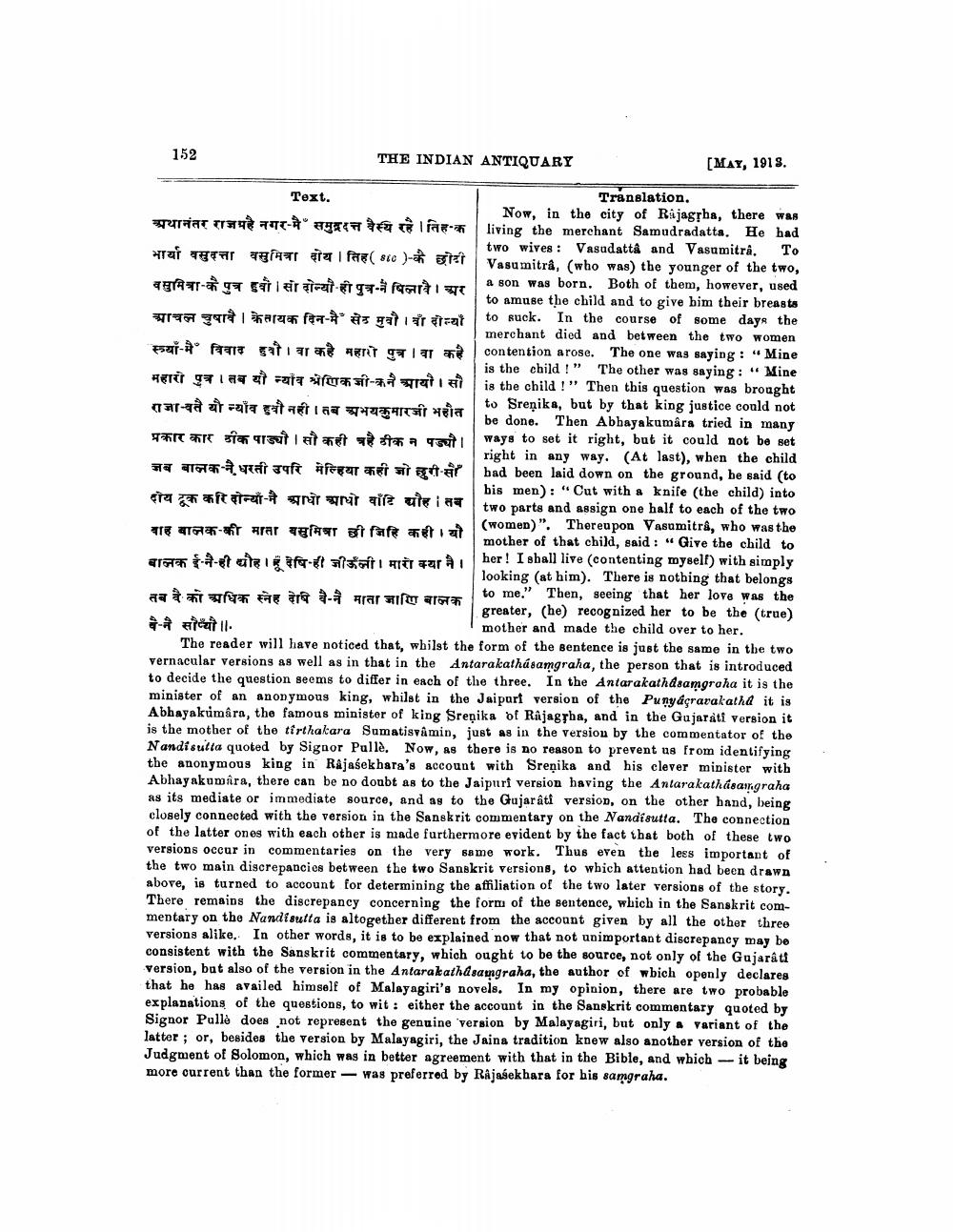________________
152
THE INDIAN ANTIQUARY
[MAY, 1913.
Text.
Translation.
Now, in the city of Rajagsha, there was अथानंतर राजमहै नगर-मै समुद्रदत्त वैस्य रहै । तिह-क | living the merchant Samudradatta. He had
two wives: Vasudatta and Vasumitra. To Hraf va fun atzifa (S60 )-* Sizi
Vasumitra, (who was) the younger of the two, Tera - E di ir izt-e ga fari
a son was born. Both of them, however, used
to amuse the child and to give him their breasts आचल चुषावै । के तायक दिन-मै सेठ मुवी । वा दोन्या to suck. In the course of some day, the
merchant diod and between the two women रूया-मैं विवाद हुयी। वा कहै महारो पुत्र । वा कहै | contention arose. The one was saying: "Mine
is the child !" The other was saying: "Mine HTC gzi au ni za u st-*arata is the child !" Then this question was brought ar-t sittain rataet 157 4734rfeia
to Sreņika, but by that king justice could not
be done. Then Abhayakumara tried in many प्रकार कार ठीक पाज्यौ । सौ कही है ठीक न पज्यौ । ways to set it right, but it could not be set
right in any way. (At last), when the child जब बालक नै धरती उपरि मेल्हिया कही जो लुरी-सौ | bad been laid down on the ground, be said (to
bis men): "Cut with a knife (the child) into दोय टूक करि दोन्या-नै आधो आधो वाँटि योस । तब |
two parts and assign one half to each of the two
(women)". Thereupon Vasumitra, who was the वाह बालक की माता वसुमित्रा छी जिहि कही। यौ
mother of that child, said: “Give the child to 19 -et utengefo- also her var
her! I shall live contenting mysell) with simply
looking (at him). There is nothing that belongs wa h ara - Arar milu 167
to me." Then, seeing that her love was the
greater, (he) recognized her to be the true) - tl.
mother and made the child over to her. The reader will have noticed that, whilst the form of the sentence is just the same in the two vernacular versions as well as in that in the Antarakathásamgraha, the person that is introduced to decide the question seems to differ in each of the three. In the Antarakathdsamgraha it is the minister of an anonymous king, whilst in the Jaipurt version of the Punyágrarakatha it is Abhayakumara, the famous minister of king Sreņika bf Rajagsha, and in the Gujarati version it is the mother of the tirthakara Sumatisvämin, just as in the version by the commentator of the Nandisulta quoted by Signor Pulle. Now, as there is no reason to prevent us from identifying the anonymous king in Rajasekhara's account with Sreņika and his clever minister with Abhayakumara, there can be no doubt as to the Jaipuri version having the Antarakathásangraha as its mediate or immediate source, and as to the Gujarati version, on the other hand, being closely connected with the version in the Sanskrit commentary on the Nandi sutta. The connection of the latter ones with each other is made furthermore evident by the fact that both of these two versions occur in commentaries on the very same work. Thus even the less important of the two main discrepancies between the two Sanskrit versions, to which attention had been drawn above, is turned to account for determining the affiliation of the two later versions of the story. There remains the discrepancy concerning the form of the sentence, which in the Sanskrit commentary on the Nandi sutta is altogether different from the account given by all the other three versions alike. In other words, it is to be explained now that not unimportant discrepancy may be consistent with the Sanskrit commentary, which ought to be the source, not only of the Gujarati version, but also of the version in the Antarakathasangraha, the author of which openly declares that he has availed himself of Malayagiri's novels. In my opinion, there are two probable explanations of the questions, to wit: either the account in the Sanskrit commentary quoted by Signor Pulle does not represent the genuine version by Malayagiri, but only a variant of the latter ; or, besides the version by Malayagiri, the Jaina tradition knew also another version of the Judgment of Solomon, which was in better agreement with that in the Bible, and which it being more current than the former – was preferred by Rajasekhara for his samgraha.




